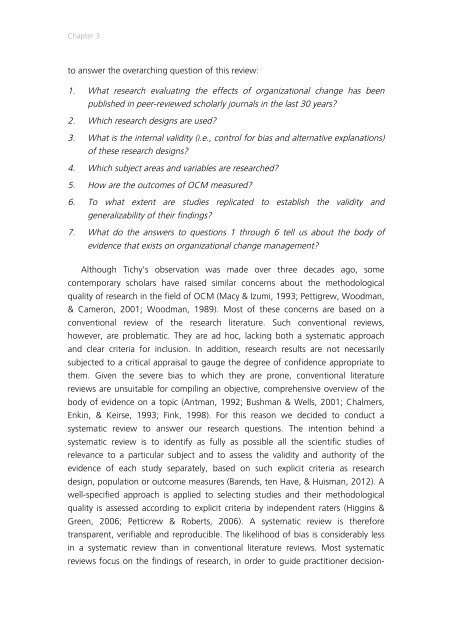In Search of Evidence
jqluvth
jqluvth
Create successful ePaper yourself
Turn your PDF publications into a flip-book with our unique Google optimized e-Paper software.
Chapter 3<br />
to answer the overarching question <strong>of</strong> this review:<br />
1. What research evaluating the effects <strong>of</strong> organizational change has been<br />
published in peer-reviewed scholarly journals in the last 30 years?<br />
2. Which research designs are used?<br />
3. What is the internal validity (i.e., control for bias and alternative explanations)<br />
<strong>of</strong> these research designs?<br />
4. Which subject areas and variables are researched?<br />
5. How are the outcomes <strong>of</strong> OCM measured?<br />
6. To what extent are studies replicated to establish the validity and<br />
generalizability <strong>of</strong> their findings?<br />
7. What do the answers to questions 1 through 6 tell us about the body <strong>of</strong><br />
evidence that exists on organizational change management?<br />
Although Tichy's observation was made over three decades ago, some<br />
contemporary scholars have raised similar concerns about the methodological<br />
quality <strong>of</strong> research in the field <strong>of</strong> OCM (Macy & Izumi, 1993; Pettigrew, Woodman,<br />
& Cameron, 2001; Woodman, 1989). Most <strong>of</strong> these concerns are based on a<br />
conventional review <strong>of</strong> the research literature. Such conventional reviews,<br />
however, are problematic. They are ad hoc, lacking both a systematic approach<br />
and clear criteria for inclusion. <strong>In</strong> addition, research results are not necessarily<br />
subjected to a critical appraisal to gauge the degree <strong>of</strong> confidence appropriate to<br />
them. Given the severe bias to which they are prone, conventional literature<br />
reviews are unsuitable for compiling an objective, comprehensive overview <strong>of</strong> the<br />
body <strong>of</strong> evidence on a topic (Antman, 1992; Bushman & Wells, 2001; Chalmers,<br />
Enkin, & Keirse, 1993; Fink, 1998). For this reason we decided to conduct a<br />
systematic review to answer our research questions. The intention behind a<br />
systematic review is to identify as fully as possible all the scientific studies <strong>of</strong><br />
relevance to a particular subject and to assess the validity and authority <strong>of</strong> the<br />
evidence <strong>of</strong> each study separately, based on such explicit criteria as research<br />
design, population or outcome measures (Barends, ten Have, & Huisman, 2012). A<br />
well-specified approach is applied to selecting studies and their methodological<br />
quality is assessed according to explicit criteria by independent raters (Higgins &<br />
Green, 2006; Petticrew & Roberts, 2006). A systematic review is therefore<br />
transparent, verifiable and reproducible. The likelihood <strong>of</strong> bias is considerably less<br />
in a systematic review than in conventional literature reviews. Most systematic<br />
reviews focus on the findings <strong>of</strong> research, in order to guide practitioner decision-


